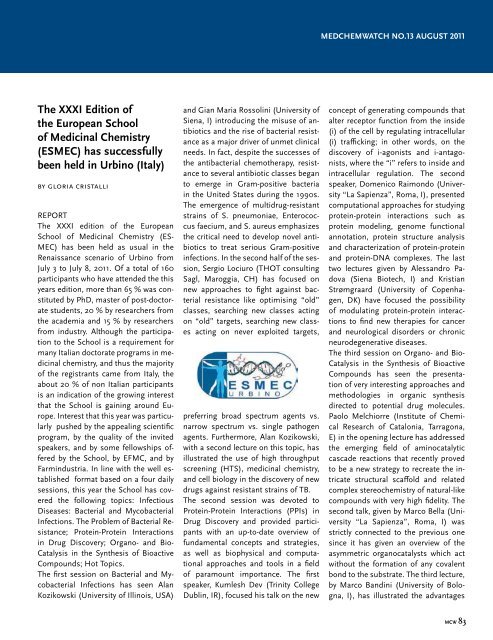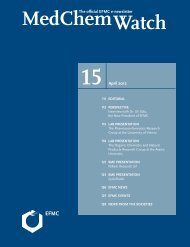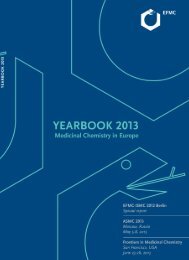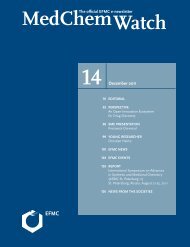Download MedChemWatch in PDF format - EFMC
Download MedChemWatch in PDF format - EFMC
Download MedChemWatch in PDF format - EFMC
Create successful ePaper yourself
Turn your PDF publications into a flip-book with our unique Google optimized e-Paper software.
MEDCHEMWATCH NO.13 AUGUST 2011<br />
The XXXI Edition of<br />
the European School<br />
of Medic<strong>in</strong>al Chemistry<br />
(ESMEC) has successfully<br />
been held <strong>in</strong> Urb<strong>in</strong>o (Italy)<br />
by gloria cristalli<br />
REPORT<br />
The XXXI edition of the European<br />
School of Medic<strong>in</strong>al Chemistry (ES-<br />
MEC) has been held as usual <strong>in</strong> the<br />
Renaissance scenario of Urb<strong>in</strong>o from<br />
July 3 to July 8, 2011. Of a total of 160<br />
participants who have attended the this<br />
years edition, more than 65 % was constituted<br />
by PhD, master of post-doctorate<br />
students, 20 % by researchers from<br />
the academia and 15 % by researchers<br />
from <strong>in</strong>dustry. Although the participation<br />
to the School is a requirement for<br />
many Italian doctorate programs <strong>in</strong> medic<strong>in</strong>al<br />
chemistry, and thus the majority<br />
of the registrants came from Italy, the<br />
about 20 % of non Italian participants<br />
is an <strong>in</strong>dication of the grow<strong>in</strong>g <strong>in</strong>terest<br />
that the School is ga<strong>in</strong><strong>in</strong>g around Europe.<br />
Interest that this year was particularly<br />
pushed by the appeal<strong>in</strong>g scientific<br />
program, by the quality of the <strong>in</strong>vited<br />
speakers, and by some fellowships offered<br />
by the School, by <strong>EFMC</strong>, and by<br />
Farm<strong>in</strong>dustria. In l<strong>in</strong>e with the well established<br />
<strong>format</strong> based on a four daily<br />
sessions, this year the School has covered<br />
the follow<strong>in</strong>g topics: Infectious<br />
Diseases: Bacterial and Mycobacterial<br />
Infections. The Problem of Bacterial Resistance;<br />
Prote<strong>in</strong>-Prote<strong>in</strong> Interactions<br />
<strong>in</strong> Drug Discovery; Organo- and Bio-<br />
Catalysis <strong>in</strong> the Synthesis of Bioactive<br />
Compounds; Hot Topics.<br />
The first session on Bacterial and Mycobacterial<br />
Infections has seen Alan<br />
Kozikowski (University of Ill<strong>in</strong>ois, USA)<br />
and Gian Maria Rossol<strong>in</strong>i (University of<br />
Siena, I) <strong>in</strong>troduc<strong>in</strong>g the misuse of antibiotics<br />
and the rise of bacterial resistance<br />
as a major driver of unmet cl<strong>in</strong>ical<br />
needs. In fact, despite the successes of<br />
the antibacterial chemotherapy, resistance<br />
to several antibiotic classes began<br />
to emerge <strong>in</strong> Gram-positive bacteria<br />
<strong>in</strong> the United States dur<strong>in</strong>g the 1990s.<br />
The emergence of multidrug-resistant<br />
stra<strong>in</strong>s of S. pneumoniae, Enterococcus<br />
faecium, and S. aureus emphasizes<br />
the critical need to develop novel antibiotics<br />
to treat serious Gram-positive<br />
<strong>in</strong>fections. In the second half of the session,<br />
Sergio Lociuro (THOT consult<strong>in</strong>g<br />
Sagl, Maroggia, CH) has focused on<br />
new approaches to fight aga<strong>in</strong>st bacterial<br />
resistance like optimis<strong>in</strong>g “old”<br />
classes, search<strong>in</strong>g new classes act<strong>in</strong>g<br />
on “old” targets, search<strong>in</strong>g new classes<br />
act<strong>in</strong>g on never exploited targets,<br />
preferr<strong>in</strong>g broad spectrum agents vs.<br />
narrow spectrum vs. s<strong>in</strong>gle pathogen<br />
agents. Furthermore, Alan Kozikowski,<br />
with a second lecture on this topic, has<br />
illustrated the use of high throughput<br />
screen<strong>in</strong>g (HTS), medic<strong>in</strong>al chemistry,<br />
and cell biology <strong>in</strong> the discovery of new<br />
drugs aga<strong>in</strong>st resistant stra<strong>in</strong>s of TB.<br />
The second session was devoted to<br />
Prote<strong>in</strong>-Prote<strong>in</strong> Interactions (PPIs) <strong>in</strong><br />
Drug Discovery and provided participants<br />
with an up-to-date overview of<br />
fundamental concepts and strategies,<br />
as well as biophysical and computational<br />
approaches and tools <strong>in</strong> a field<br />
of paramount importance. The first<br />
speaker, Kumlesh Dev (Tr<strong>in</strong>ity College<br />
Dubl<strong>in</strong>, IR), focused his talk on the new<br />
concept of generat<strong>in</strong>g compounds that<br />
alter receptor function from the <strong>in</strong>side<br />
(i) of the cell by regulat<strong>in</strong>g <strong>in</strong>tracellular<br />
(i) traffick<strong>in</strong>g; <strong>in</strong> other words, on the<br />
discovery of i‐agonists and i‐antagonists,<br />
where the “i” refers to <strong>in</strong>side and<br />
<strong>in</strong>tracellular regulation. The second<br />
speaker, Domenico Raimondo (University<br />
“La Sapienza”, Roma, I), presented<br />
computational approaches for study<strong>in</strong>g<br />
prote<strong>in</strong>-prote<strong>in</strong> <strong>in</strong>teractions such as<br />
prote<strong>in</strong> model<strong>in</strong>g, genome functional<br />
annotation, prote<strong>in</strong> structure analysis<br />
and characterization of prote<strong>in</strong>-prote<strong>in</strong><br />
and prote<strong>in</strong>-DNA complexes. The last<br />
two lectures given by Alessandro Padova<br />
(Siena Biotech, I) and Kristian<br />
Strømgraard (University of Copenhagen,<br />
DK) have focused the possibility<br />
of modulat<strong>in</strong>g prote<strong>in</strong>-prote<strong>in</strong> <strong>in</strong>teractions<br />
to f<strong>in</strong>d new therapies for cancer<br />
and neurological disorders or chronic<br />
neurodegenerative diseases.<br />
The third session on Organo- and Bio-<br />
Catalysis <strong>in</strong> the Synthesis of Bioactive<br />
Compounds has seen the presentation<br />
of very <strong>in</strong>terest<strong>in</strong>g approaches and<br />
methodologies <strong>in</strong> organic synthesis<br />
directed to potential drug molecules.<br />
Paolo Melchiorre (Institute of Chemical<br />
Research of Catalonia, Tarragona,<br />
E) <strong>in</strong> the open<strong>in</strong>g lecture has addressed<br />
the emerg<strong>in</strong>g field of am<strong>in</strong>ocatalytic<br />
cascade reactions that recently proved<br />
to be a new strategy to recreate the <strong>in</strong>tricate<br />
structural scaffold and related<br />
complex stereochemistry of natural-like<br />
compounds with very high fidelity. The<br />
second talk, given by Marco Bella (University<br />
“La Sapienza”, Roma, I) was<br />
strictly connected to the previous one<br />
s<strong>in</strong>ce it has given an overview of the<br />
asymmetric organocatalysts which act<br />
without the <strong>format</strong>ion of any covalent<br />
bond to the substrate. The third lecture,<br />
by Marco Band<strong>in</strong>i (University of Bologna,<br />
I), has illustrated the advantages<br />
MCW 83





